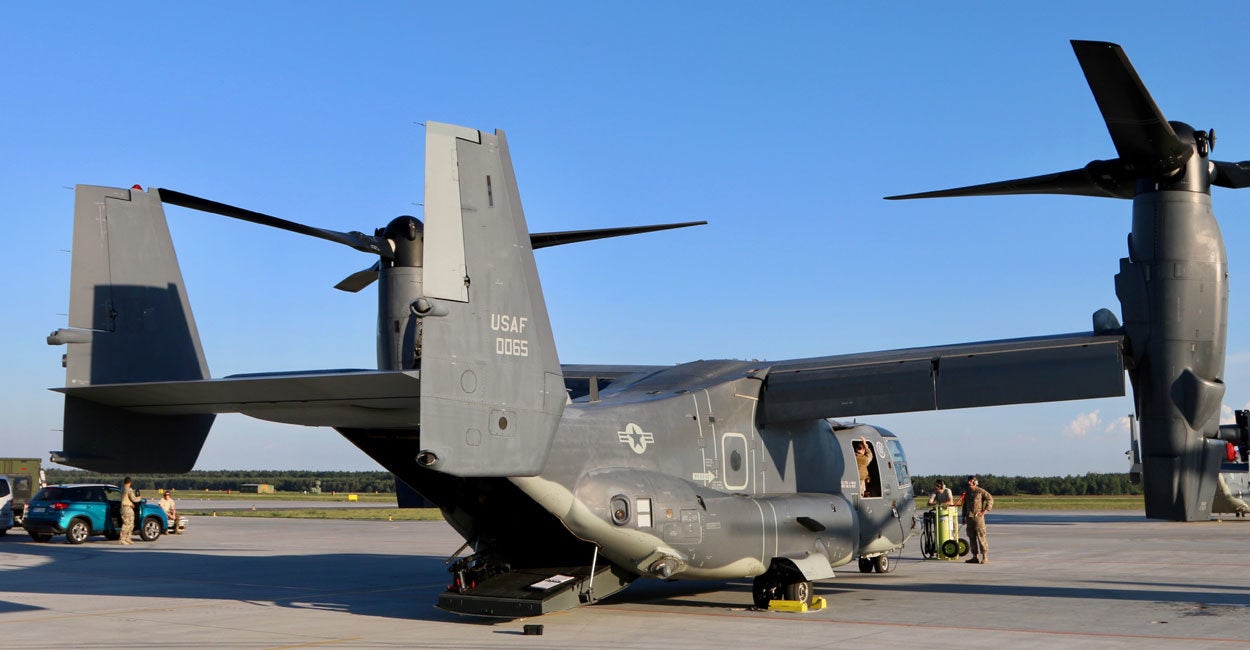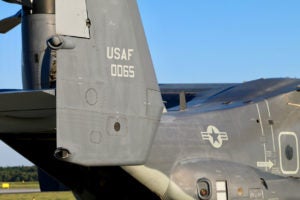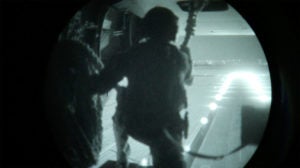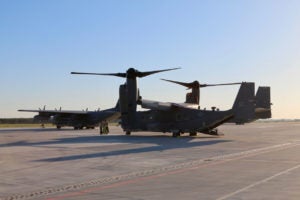DOLASZEWO, Poland—In less than 72 hours, U.S. special operations forces transformed a nondescript reserve base at this village in the bucolic Polish countryside into the headquarters of a simulated, special operations war to liberate NATO’s three Baltic countries from a land invasion.
Looking in from outside the perimeter wire, however, you’d never know it.
Only a few, unassuming radio antennas dot the area around an old warehouse inside of which U.S. special operations personnel have set up their operations center.
The Daily Signal depends on the support of readers like you. Donate now
Some soldiers mill about within the base grounds. A few have noticeably athletic builds, beards, and a way of looking through you, not at you, that is common among U.S. special operators (especially when they cross paths with a journalist).
U.S. special operations forces from multiple branches were training here in Poland as part of a regional exercise called Trojan Footprint, which ran from late May until early June.
Comprising about 2,000 special operations and conventional force personnel from 13 countries, Trojan Footprint was a dry run for the covert, special operations-led resistance war—known in military circles as unconventional warfare—that would precede a conventional NATO counteroffensive to reverse a Russian invasion of the Baltics.
Participating from the U.S. side: U.S. Army Special Forces (the “Green Berets”) from the European-based 10th Special Forces Group, as well as U.S. Navy SEALs, and a U.S. Air Force special operations air task unit flying CV-22 Ospreys and MC-130 Talons. Also, U.S. F-16 fighters, B-1 bombers, and AC-130 gunships took part in the exercise.
“This is varsity level,” said U.S. Army Maj. Michael Weisman, public affairs director for U.S. Special Operations Command Europe.
For their part, the U.S. forces were training to rapidly deploy and wage a covert, resistance war alongside the Baltic region’s indigenous territorial defense forces.
Territorial defense forces comprise a gamut of irregular, volunteer military forces in the three Baltic countries of Estonia, Latvia, and Lithuania. They range from the Latvian National Guard to the Estonian Defense League, a civilian paramilitary group that holds weekend training events for its 25,400 volunteers to learn partisan warfare.
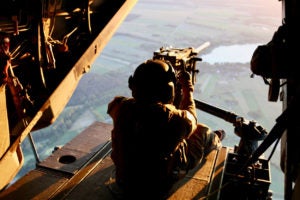
A U.S. Air Force special operations CV-22 Osprey flies across the Suwalki Gap, crossing the border from Poland to Lithuania. (Photos: Nolan Peterson/The Daily Signal)
Working with these units in Trojan Footprint, U.S. special operations forces simulated an operation to “clear the way” for a counteroffensive by NATO’s conventional military forces to liberate the Baltics from an invasion.
“[Special operations forces] aren’t going to run an adversary out of the Baltics on our own,” said U.S. Army Col. Lawrence Ferguson, 10th Special Forces Group commander, during an interview in Dolaszewo.
“Our purpose here is to prepare the battlefield for conventional forces,” said Ferguson, a 1990 U.S. Air Force Academy graduate who cross-commissioned into the Army.
When asked to explain what preparing the battlefield entailed, Ferguson responded: “It’s about identifying enemy vulnerabilities and exploiting them.”
The Trojan Footprint exercise does not outright name Russia as the simulated adversary (the simulated foe is referred to as a “near-peer” adversary). Yet, U.S. military officials do not shy away from openly stating that one of the exercise’s key overall objectives is to deter Russia from military aggression in the Baltic region.
“I put a lot of stock in the deterrent effect of us being here,” Ferguson said. “Our constant presence in the Baltics sends a clear signal that we’re going to take any sort of shenanigans seriously. I think that’s an important message to send.”
The Special Forces commander paused, narrowed his eyes a touch, and added: “Going to war with America is no joke.”
‘We’re Learning’
Apart from sending a message to Moscow, one key goal of Trojan Footprint was to rehearse the logistical and administrative components of rapidly spinning up an expeditionary, unconventional war—something most U.S. special operations forces have not done since the period immediately following the Sept. 11, 2001, terrorist attacks.
“We’ve been fighting in the Middle East and Iraq for so long, it’s plug and play,” Ferguson said. “In Iraq and Afghanistan we have a robust infrastructure—we’ve gotten accustomed to it.”
In less than 72 hours at the exercise’s outset, U.S. special operations forces had moved into the military facility in Dolaszewo, and spun up their operations from scratch.
“We’re here and we’re learning,” Ferguson said.
With similar speed, the Air Force special operations air task unit set up shop at the Polish air force’s 33rd Air Base, near Powidz. On site, the special operations aircrews and their support personnel ate MREs (meals ready to eat) and lived in tents—roughing it by Air Force standards.
Prior to Trojan Footprint, commanders gave sparse advance notification to their personnel about where they were going. More broadly, the entire exercise was kept under wraps and out of the public eye. All to make the training scenario as real—that’s to say, as chaotic—as possible.
“We’re making this as real as we can,” said the commander of the Air Force special operations air task unit deployed to the 33rd Air Base in support of Trojan Footprint. “There was nothing here, we came in blind.”
The Air Force special operations commander, a lieutenant colonel, asked that his name not be published due to security concerns—typical protocol for special operations personnel.
A conventional NATO counteroffensive to liberate the Baltics from a land invasion could take weeks to mobilize and deploy, U.S. officials said. Thus, the U.S. special operations forces taking part in Trojan Footprint trained to be self-sufficient.
At Dolaszewo, the U.S. troops brought their own kitchens, tents, and bathrooms. The abandoned warehouse they transformed into their operations center was chock-full of computers and communications equipment—flat screen TVs hung from the walls, the ground was a morass of bundled, multicolored cables. Cardboard dividers suspended from the ceiling cut down on echo in the bare, concrete space.
Outside, the arrays of satellite antennas were discreet. To save time spinning up operations from the get-go, U.S. forces relied on their military communications network, as well as the local communications grid.
Truly, the fact that an entire covert war could be run from this makeshift location was not overtly obvious to a casual passerby.
“The point of the exercise is to rapidly deploy special operations forces into Poland and the Baltics on short notice—and quietly,” Weisman said.
At the 33rd Air Base near Powidz, U.S. Air Force special operations personnel turned an abandoned Soviet-era control tower into their operations center. Inside the tired structure, these elite aviation units had crammed their high-tech, sensitive equipment into a few rooms.
As aircrew brushed past in the narrow hallways, the air task unit commander grinned, explaining that the tight quarters made the training environment more uncomfortable, and more stressful.
“It gets hot in there,” he said, standing with arms folded. That particular commander has a reputation for working long hours. He’s also a combat-tested pilot, with 10 years experience flying the CV-22, and seven years of experience flying MH-53 Pave Low helicopters prior to that.
As do most pilots of his generation in the U.S. military, this Air Force lieutenant colonel has multiple deployments to Iraq “and other places” under his belt.
In his early 40s, the commander is older than most of the personnel under his command. Thus, for him, the historical significance of the exercise is particularly poignant.
“My dad defended the Fulda Gap, and now it’s the Suwalki Gap,” the special operations air task unit commander said.
During the Cold War, NATO planners considered the Fulda Gap—a lowland corridor northeast of Frankfurt, Germany—to be the most likely route for a Soviet tank invasion of West Germany.
On May 28, as part of Trojan Footprint, and with this correspondent onboard, an Air Force special operations CV-22 aircrew flew a mission north from Poland across the Suwalki Gap and into Lithuania.
The Suwalki Gap is a 60-mile-wide land corridor connecting Poland to Lithuania. It’s the only land connection between NATO’s three Baltic countries and the rest of the alliance—it’s also bordered to the west by Russia’s Kaliningrad exclave and to the east by Russia’s ally, Belarus.
Many military experts say the Suwalki Gap is the most likely target for a Russian invasion of the Baltics—a move that would effectively seal off the Baltics from any overland reinforcements by NATO forces staged elsewhere in the region.
How It Would Go
A 2016 report by the RAND Corp., a U.S. think tank, concluded that Russian forces could invade to the edge of Estonia’s capital of Tallinn or the Latvian capital of Riga in 36 to 60 hours.
“As currently postured, NATO cannot successfully defend the territory of its most exposed members,” the report said.
The RAND report caused a stir among Western military brass.
Following the July 2016 NATO summit in Warsaw, the alliance began rotating four battalion-size, combat-ready battlegroups throughout the Baltic region. Of those forces, the U.S. has about 800 troops stationed in Poland, including a squadron of Stryker armored fighting vehicles with towed artillery.
Yet, some military experts say NATO’s rotating deployments are “tripwire forces” incapable of repelling a Russian invasion, and their presence is presumably meant to deter Russia from an attack due to the risk of spurring NATO to defend its forward units.
Russia’s invasion of Ukraine has rattled NATO’s three Baltic members of Latvia, Lithuania, and Estonia—as well as neighboring Poland. Collectively, these countries treat Russian military aggression as an existential threat.
Russian military brinksmanship across Eastern Europe has further heightened tensions—those acts include the buzzing of NATO ships and aircraft by Russian warplanes, as well as subversive propaganda campaigns and cyberattacks to stir separatism among minority Russian populations in the region.
Due to the Russian threat, NATO’s Baltic members have taken unilateral measures to bolster their defenses. They have all dramatically increased their military budgets since 2014. Yet, their regular forces are still overwhelmed by Russian forces in the region, experts say.
Thus, the national defense plans of the Baltic countries call for the general mobilization of their societies to mount a war of resistance should Russia invade.
“The Russian side is trying to destroy our society,” Lt. Gen. Leonids Kalnins, Latvia’s chief of defense, told The Daily Signal in an interview. “The responsibility of defending the nation falls to every citizen.”
“These nations don’t have the ability to oppose a significant incursion … their national defense plans are built on resistance,” said Ferguson, the U.S. Army Special Forces commander. “We’re trying to ensure that they have a legitimate resistance capability.”
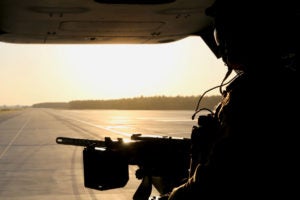
Looking out the back of a CV-22 Osprey during a training flight in Poland, as part of the Trojan Footprint exercise.
The legacy of World War II paramilitary units runs deep in the Baltic states and Poland, where citizens fought back against both Nazi and Red Army invaders.
Reflecting the historically ingrained resistance mindset, the ranks of territorial defense forces in NATO’s Baltic countries have swelled since Russia’s military intervention in Ukraine in 2014.
“Nobody is afraid of Russia in Latvia, but we’re concerned about something unpolite from Russia,” Kalnins said. “They have many military units near our borders … all the scenarios in Russia’s exercises are oriented to attack, not to defend.”
In neighboring Lithuania, conscription has been reinstated. The government also recently issued a guerrilla warfare manual for the country’s 3 million citizens.
Out of an overall population of 1.3 million, Estonia’s standing army comprises about 6,000 troops, while its Defense League—a civilian paramilitary force—includes roughly 25,400 volunteers.
With about 8,000 troops in its ranks, Latvia’s National Guard is the largest component of the country’s armed forces, and forms the crux of its “comprehensive defense” strategy to resist a Russian invasion.
“The National Guard plays a very big role—it’s the main power to defend our country,” Kalnins, Latvia’s defense chief, said. “Our society has to be ready to defend our country, our citizens have to be ready to defend our country.”
The Latvian Ministry of Defense has plans for six new National Guard battalion bases by 2021. Yet, Latvia’s “comprehensive defense” plan is not just steeling its National Guard and regular army for war—Latvian society as a whole is being hardened to the task.
Latvia recently implemented new security laws to make it easier to carry out a general mobilization of all citizens in the event of an invasion, as well as to bolster “social resiliency”—an effort to prepare civilians to endure the hardships of a resistance war.
A recent poll in Latvia indicated that about a third of respondents were willing to take part in a resistance war should Russia invade. One-third said they would do nothing, and the remainder said they would leave the country.
“The civilian and governmental structures must train together,” Kalnins told The Daily Signal. “No matter how old you are, you are responsible for defending the country. Nobody has to wait for a special order, everyone is responsible in any attack.”
Back to the Future
Unconventional warfare has been the U.S. Army Special Forces’ bread and butter mission since the Cold War.
“It was their primary mission then, and has never gone away,” said Steven Bucci, a visiting fellow in foreign and national security policy at The Heritage Foundation who served for three decades as an Army Special Forces officer.
The 10th Special Forces Group stood up in 1942 and focused on the Soviet threat to Eastern Europe during the Cold War. After 17 years of counterinsurgency operations, exercises like Trojan Footprint mark a return to roots of sorts for the storied Special Forces unit.
“Now, our primary focus as an organization is on Europe,” Ferguson said.
However, noting recent combat casualties, the Special Forces commander added: “The fight in Afghanistan hasn’t gone away.”
The post-9/11 warfare era is not over. U.S special operations forces still maintain an unending combat operations tempo across the globe to combat the terrorist threat. But “near-peer” state adversaries have re-emerged as potential military threats from the South China Sea to the Baltics.
In light of these new global threats, there has been a renewed emphasis within the Special Forces community to “reinvigorate their unconventional warfare chops,” Bucci said.
“We always need to be ready to conduct operations in different locations, at different levels of war, against diverse adversaries,” Bucci said. “[Special Forces] is a big part of that flexibility. They do not replace conventional forces, but can give our leaders a little breathing space and creativity.”
Counterinsurgency campaigns in the post-9/11 era have left U.S. special operations forces—across all branches—battle-hardened and combat-tested.
They are experts in their craft. Still, U.S. special operations commanders say their forces lack experience fighting the kind of resistance war simulated in the Trojan Footprint exercise.
“We had supremacy in every aspect of warfare in the Middle East—we dominated,” Ferguson said.
“But we haven’t fought an adversary on our level in a long time,” the Special Forces commander added. “We have to be prepared to fight in an environment where the enemy has significant advantages.”
U.S. special operations forces do, however, possess a generation of experience fighting against the very kind of endemic resistance campaigns they are training to wage behind the front lines of a Russian invasion force.
The wars in Iraq, Afghanistan, and Syria have been a 17-year education in combating an enemy that “hides among the population,” Ferguson said.
“Shame on us if we haven’t learned lessons in the wars we’ve fought,” he added.
“There’s always inherent value to experience combat,” Ferguson continued. “The difference here is we’re going to be in occupied territory. America fights on the offensive. Our doctrine is about decisive action—our mission is to shape the battlespace for decisive action.”
For his part, Ferguson said he’s doing more to prepare for war than simply poring over myriad battlefield tactics and strategies.
“I want to understand the Russian mindset,” Ferguson said, “I want to understand their way of thinking.”
Part of that education comes from literature. Part of it comes from interacting with troops from America’s contemporary NATO allies who used to be a part of the Soviet Union’s armed forces.
“We learn a lot about how [the Russians] think from those guys,” Ferguson said.
Smoke Signals
The U.S. and its NATO partners have been judicious about the deployment of conventional forces to NATO’s eastern flank so as not to spur a tit-for-tat escalation with Russia.
But that doesn’t mean NATO has abdicated its responsibility to defend the Baltics.
Through Trojan Footprint, the U.S. and its NATO partners advertised to Moscow that an incursion into sovereign NATO territory would immediately spur a resistance war in the lead-up to a conventional counteroffensive.
Some NATO brass say that sends a clear message to the Kremlin to not mistake the relative paucity of NATO conventional forces in the Baltic region with the assumption that an invasion would be a cakewalk, or that NATO is unprepared to strike back immediately, and lethally.
“If we show the high willingness of Latvian society to be ready to respond to any aggression, it’s the very best of our military tools to show real deterrence against Russia,” Kalnins said. “I absolutely believe that nobody would like to attack a country when all of society is mobilized to its defense.”
“It would be high-risk operation by Russia,” Kalnins added.
The Heritage Foundation’s Bucci said the emphasis on unconventional warfare helps deter Russian aggression—but conventional NATO forces are still needed in the Baltics.
“Unconventional warfare is a powerful enabler, but does not replace an adequate conventional force,” Bucci said. “In the same way we don’t deter only with air power, or only with ground, we need it all. A credible unconventional warfare capability adds to the deterrent, but cannot do it alone.”
For Ferguson, the Trojan Footprint exercise sends a clear message to Moscow: The U.S. is ready to go to war to protect its NATO allies.
“We take [Russia] deadly seriously,” Ferguson said. “We need them to know the Baltics are not worth the risks. And our being here tells them that.”
Operations like Trojan Footprint also send a reassuring message to America’s NATO allies—namely, that they can count on U.S. security guarantees under NATO’s collective defense commitment.
“The exercise sends a reassuring message to the Latvian people that they can count on the U.S.— it shows we’re in a strong family,” Kalnins said. “U.S. special operations forces have developed our abilities and that’s a significant symbol that the U.S. is ready to stand by our side.”
Real Deal
During Trojan Footprint, U.S. special operations units trained on the site a potential battlefield.
Thus, there was a practical utility to becoming familiar with the terrain, climate, local customs, and culture. And by training shoulder-to-shoulder with the Baltic countries’ territorial defense units, U.S. special operations troops say they aimed to develop personal relationships, as well as to bolster those units’ combat capabilities.
“You can’t do the planning and build relationships after an invasion,” Weisman said.
“The relationships are already there,” Ferguson said. “If something goes sideways in the Baltics, we have to maintain our lash-up with our partners, and increase our lethality over time.”
For the CV-22 pilots, this is not a training exercise in the New Mexico desert, simulating a distant war zone. It’s a chance to fly over a potential combat zone.
“From the pilot standpoint, if I’ve been to a place, I learn a lot,” a CV-22 pilot who is a U.S. Air Force captain, told The Daily Signal during an interview at the 33rd Air Base near Powidz. “I learn the crunch points. It builds tremendous value to train in an area we’re tasked to defend.”
The pilot asked that his name not be published due to security concerns.
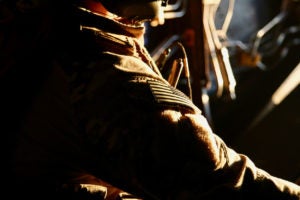
After a generation of fighting counterinsurgency wars, U.S. special operations forces in Europe are refocusing on defending the Continent.
“Here, we can utilize the terrain for our training,” another CV-22 pilot, also an Air Force captain, said. “One benefit of the training is to familiarize ourselves with the area.”
“It’s like looking at Google Maps versus actually visiting a place,” the pilot added.
One goal of Trojan Footprint for the special operations air task unit was to work out the mundane logistical details of rapidly spinning up sustained combat operations at an unfamiliar airfield. Even something as simple as knowing where to find the fuel dumps or where to store equipment can save valuable time.
“We want to work out the kinks in the logistics and focus on the operational portion of the mission,” one CV-22 pilot said.
“I don’t see success in this exercise as something we can quantify in the next few months or years,” the special operations air task unit commander said. “But if these personnel can go into combat like they trained here, that would be success.”
‘High Intensity’
As the sun set on May 28, U.S. Air Force CV-22 pilots and aircrew briefed for a training mission as part of Trojan Footprint.
Inside a cramped room in the old Soviet control tower at the 33rd Air Base, they ran through the paces of the briefing with the calm, dispassionate demeanor characteristic of U.S. military aircrews across all branches.
By special operations standards, it was a rather benign flight.
An out-and-back flight along an instrument flight rule (IFR) airway from Poland to Lithuania. They would fly to the northeast across the Suwalki Gap along an air route routinely used by civilian aircraft. At the Vilnius airport they would make a low approach but not land, before beginning the return leg to Poland.
During the several hour flight, U.S. Army combat medics in the rear of the aircraft gave each other IVs—they were onboard to familiarize themselves with operating in the interior of the CV-22 while in flight. Back in Poland, the pilots practiced hovering and aircrew in the back bay practiced employing the fast rope and hoist.
To an outside observer, it all seemed impressive, but routine.

The Soviet control tower used by an Air Force special operations unit as its headquarters in Poland.
Yet, at its core, this was a training mission to practice flying over the front lines of a Russian invasion force into airspace where U.S. forces would not enjoy air superiority.
In that type of combat environment, special operations aircraft like the CV-22 would be dangerously exposed to threats from surface-to-air missiles, warplanes, and electronic warfare weapons.
“In Iraq and Afghanistan we dominated the airspace. It’s different here,” the special operations air task unit commander said.
To prepare, U.S. special operations pilots say they are training to work in tandem with conventional forces—namely, warplanes that specialize in the suppression of enemy air defenses—in ways not required by the battlefield threats faced in Iraq and Afghanistan.
“[Special operations forces] cannot operate without conventional forces,” the special operations air task unit commander said. He added that the Trojan Footprint exercise is training “capabilities I never needed in Iraq.”
“We realize that [special operations forces] can’t do it ourselves,” the commander continued. “We now have to work with conventional forces for the [suppression of enemy air defenses].”
New Habits
Russia’s modern hybrid warfare doctrine is a modern take on the Soviet Union’s strategy of “deep battle.” Hybrid warfare is not covert warfare. Rather, it’s the combined use of conventional military force with other nonkinetic means such as cyberattacks and propaganda to sow chaos and confusion among the enemy—both on the battlefield and deep behind the front lines.
“The main aim of Russian hybrid warfare is to divide our society,” Kalnins, Latvia’s chief of defense, told The Daily Signal. “They’re using this tool to separate us.”
Hybrid warfare is an evolving threat spanning every combat domain. Consequently, the U.S. military and its NATO allies have to be adaptive, not hamstrung by rigid battle plans, and able to anticipate threats before they manifest.
The Trojan Footprint exercise represents the kind of forward thinking required of U.S. military commanders—of both special operations and conventional forces—and the eclectic skill sets required of their troops to successfully defend against the contemporary Russian military threat—and to do so with, effectively, one hand tied behind their back.
Ferguson noted that U.S. forces are accustomed to being able to call in airstrikes or artillery in a pinch. But, behind the front lines of a Russian invasion force in the Baltics, U.S. forces “cannot rely on air power to break contact.”
In short, U.S. special operators are training to be on the weak side of the fight, with the possibility of being cut off from communicating with their commanders. For that reason, the decision-making autonomy of U.S. special operations units is a priority.
“They’ve got to be able to operate with minimal guidance,” Ferguson said. “They need to know the game plan if we’re unable to communicate … I may not hear from them for a long time.”
Also anticipating the Russian electronic warfare threat, the CV-22 pilots trained to operate with degraded communication and navigation equipment.
“We’re training to operate without [communications] or GPS,” the special operations air task unit commander said. “We assume we’ll have degraded systems operating.”
Although, the pilots made clear that such “degraded systems” training is part and parcel of their normal training curriculum, no matter where they fly.
“It’s our job to be tactically proficient,” one CV-22 pilot said, withholding his name for security reasons. “As a line pilot, we train for everything. We’re here for deterrence, and we prepare for that, too.”
Case Study
To anticipate what a war against Russia would look like, U.S. commanders are studying Russia’s military campaigns in Ukraine and Syria.
“It’s a great primer for us to see how Russia is fighting in Ukraine,” Ferguson said. “We have an ongoing learning laboratory by watching Russia in Ukraine and Syria.”
Based on those lessons, Ferguson downplayed the mystique sometimes ascribed to Russian “hybrid warfare.”
“We’ve got a good picture of how they’re going to fight,” Ferguson said. “It’s a standard application of force from the USSR, with modern technology.”
Asked to describe what a war in the Baltics would look like, Ferguson replied: “High-intensity combat with significant casualties.”
One key lesson from Ukraine and Syria is that Russia has an advanced electronic warfare capability, which could inflict a communications blackout on U.S forces. Additionally, Russia is able to target its weapons systems on electromagnetic emissions.
“Russia can shut this place down if they light everything up,” Ferguson said, speaking from Dolaszewo.
Along that line of thinking, in 2017, the U.S. Army’s Asymmetric Warfare Group released the “Russian New Generation Warfare Handbook,” which used the war in Ukraine as a case study in preparing U.S. forces for a war against Russia.
With the Russian threat in mind, the Army report offered a blunt assessment of the U.S. military’s need to transform after focusing on counterinsurgency operations for nearly a generation.
In particular, the report took a hard look at the U.S. military’s dependence on high-tech communications tools, which could be vulnerable to Russian electronic warfare countermeasures.
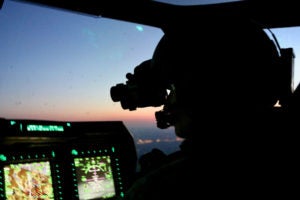
Looking out the front of a CV-22 during a training flight over the Suwalki Gap as part of Trojan Footprint.
“The U.S. reliance on robust communication infrastructure and GPS navigation means that a sudden interruption of this capability, even for a short duration, can be disastrous to an operation,” the report said.
U.S. troops have other habits to kick after a generation of counterinsurgency operations, the report said. With Russia, they’ll need to camouflage their electromagnetic emissions in ways they never had to worry about in counterinsurgency campaigns.
“We have to find creative ways to communicate,” Ferguson said, adding: “We won World War II with crappy radios and without cellphones.”
The Greatest Threat
Russian artillery, rockets, and tank shots still thunder over Europe’s only ongoing land war in eastern Ukraine, and the threat of Russian military aggression looms large over countries on NATO’s eastern flank in the Baltics.
Russia maintains the world’s largest nuclear weapons arsenal, and the specter of a nuclear exchange looms large over any hypothetical military confrontation between NATO and Russia. As in the Cold War, when it comes to the contemporary Russian military threat, the greatest enemy is war itself.
Considering what’s at stake, Ferguson said exercises like Trojan Footprint are “as important as what’s going on in Iraq and Afghanistan.”
“I don’t want the American people to worry about a nuclear war with Russia,” Ferguson said. “That’s why we’re here.”





























